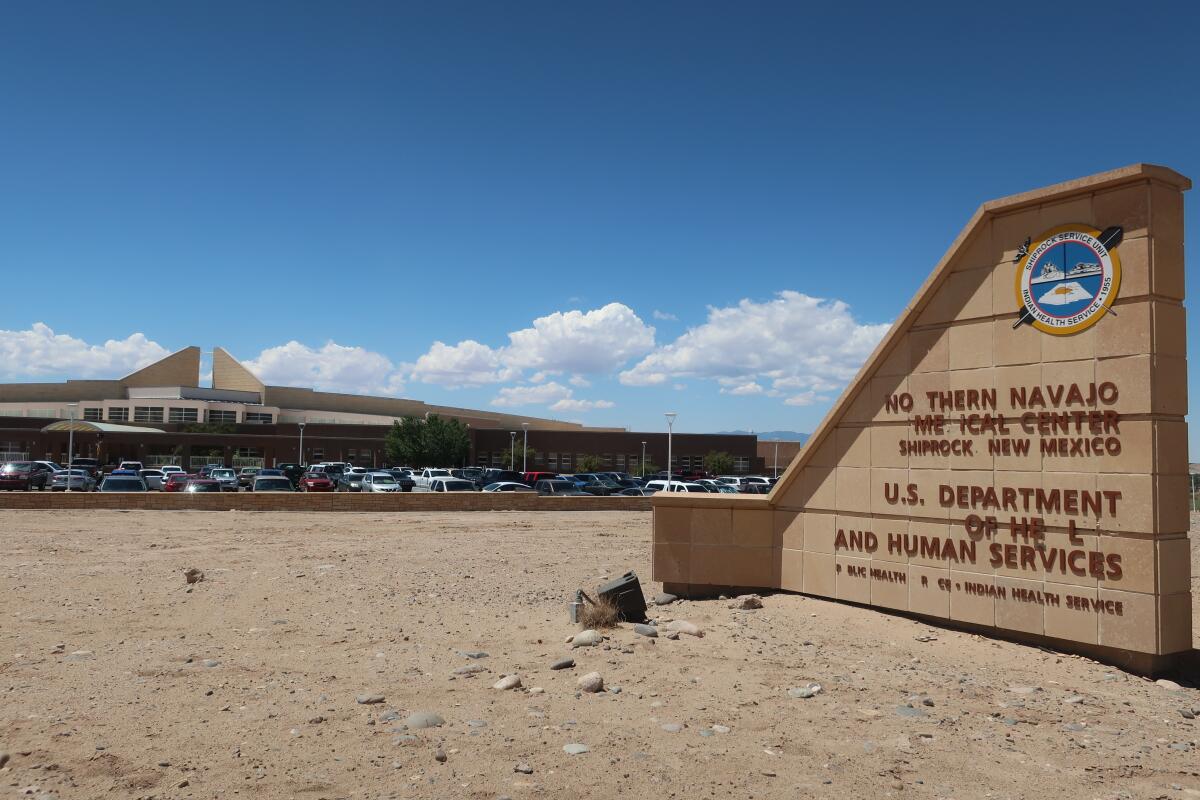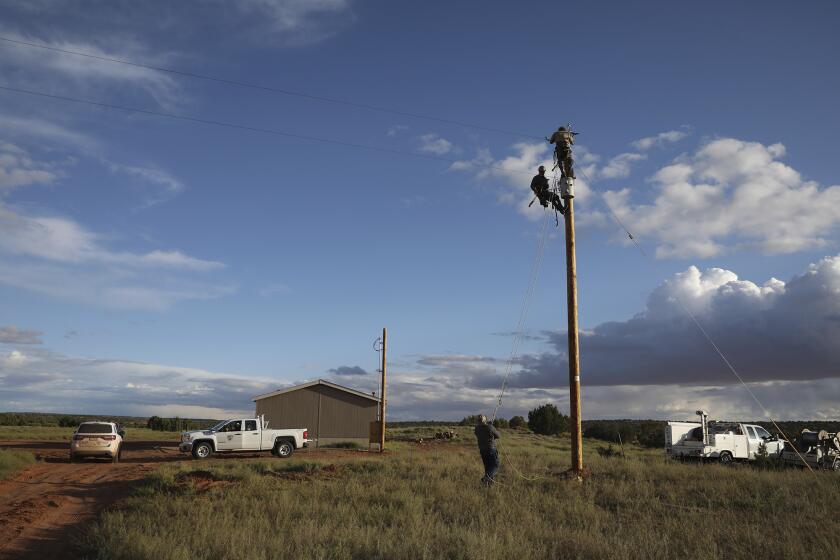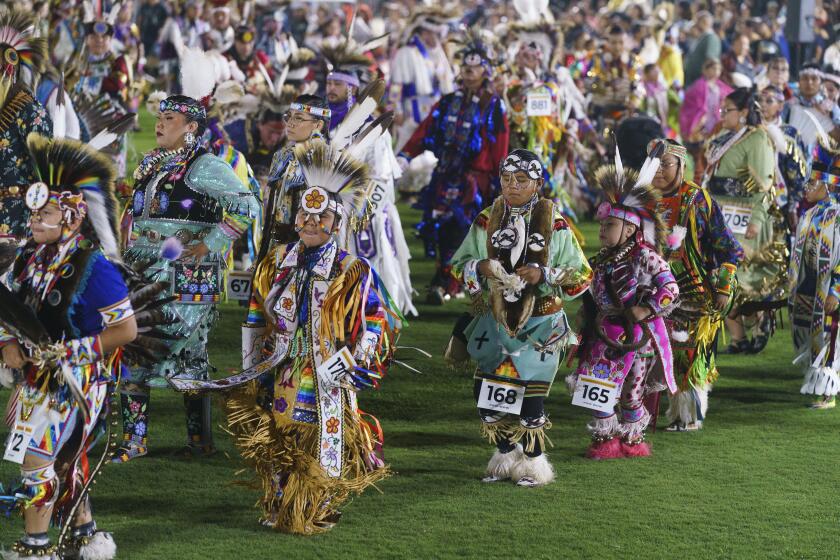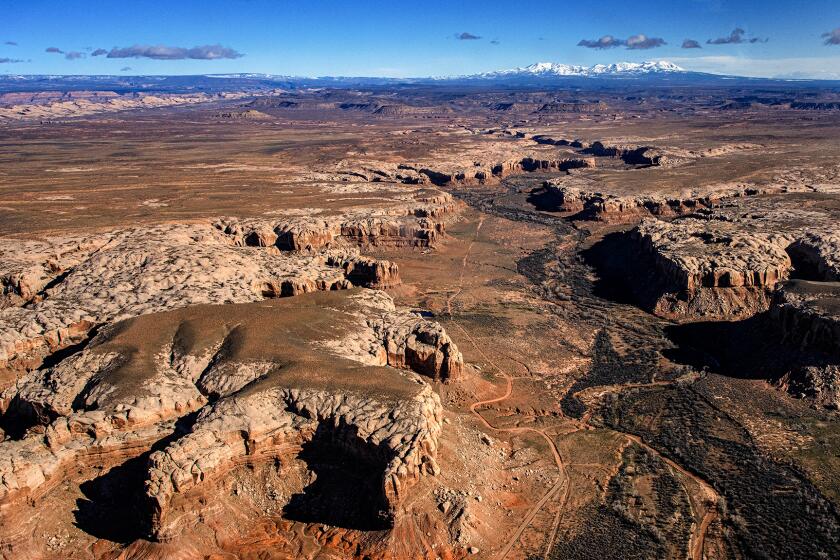Opinion: Native Americans face huge healthcare disparities. Here’s a way to help close the gaps

One of my patients who lives in Diné Bikéyah, the vast Navajo reservation in New Mexico, sleeps in an old Ford pickup truck that often doesn’t start. He has heart failure and relies on oxygen. But since he is without electricity, he spends his nights sneaking into the Walmart parking lot to charge his oxygen concentrator so he can survive another day.
For more than a year, he has needed coronary artery bypass surgery. But he can’t drive himself to the hospital three hours away, and his friends can’t afford the gas to take him. Each time his phone is out of service, I wonder whether it’s a coverage gap or an unpaid bill. Or something worse.
Such health concerns are common on the nation’s largest reservation. American Indians have the highest mortality and lowest life expectancy of any racial group in the U.S., according to the Centers for Disease Control and Prevention. My team’s research shows that nearly half of American Indians on Medicare suffer from a serious heart problem. And the life expectancy at birth for American Indian-Alaska Native people was 65.2 years in 2021 — equal to that of the U.S. population overall in 1944.
A major social theory focused on premature mortality for white Americans — but excluded data representing Indigenous people.
These disparities are not genetic but rather a result of generations of land theft, broken treaty obligations, forced displacement, discrimination and Indigenous genocide, all of which have fueled poverty as well as the worst health inequities in our nation.
Many treaties that ceded tribal lands to the U.S. required high-quality health services in return. That’s why the Indian Health Service was established. But the Indian health system remains grossly under-resourced and underfunded. IHS hospitals are four decades old on average, compared with the national average of 10.6 years; Veterans Affairs treats about 3.5 times as many patients as the IHS but employs 15 times as many physicians. The U.S. government budgeted $4,104 per patient enrolled in the Indian Health Service in 2018, compared with $8,093 per Medicaid enrollee, $13,257 per Medicare enrollee and $9,574 per VA patient.
These numbers mean that Native American people get less care and as a result die younger. They perpetuate a message that an Indigenous life is worth less than everyone else’s.
There have been improvements in recent years. The Supreme Court ruled this month that the federal government must cover related administrative costs for tribes that take over their own healthcare programs. And last year, the government raised the IHS budget to $7.1 billion, which represents a 68% increase over the last decade. But those victories won’t fill all the gaps.
San Diego County’s San Luis Rey Band of Mission Indians is one of a number of tribes in the state that are still fighting for federal acknowledgment.
At the University of New Mexico School of Medicine, I worked with the Indian Health Service and saw firsthand the incredible burden of disease and pervasive injustice. Now, as a cardiologist with the IHS at Gallup Indian Medical Center and as a health equity researcher, I focus largely on improving heart care for the Navajo community. The area has profound social needs: Unpaved roads and inclement weather are common, poverty is widespread, and thousands of residents lack electricity or running water. (Last year, the Supreme Court ruled 5 to 4, in Arizona vs. Navajo Nation, that the U.S. is not obligated to secure the tribe’s water needs across the reservation.)
In the Eastern Navajo community, heart failure reflects the acute challenges for care. Recommended lifesaving medications were being used by only 23% of our patients. As our team thought about how to better serve this group, we realized we had to listen — to center community voices. We had to reject the typical U.S. care model that relies on patients to make it to the doctor, a process that benefits affluent and white patients who face fewer barriers to care. On the reservation, we can’t wait for an elder to reach out when he is isolated at home, unable to breathe and has his truck stuck in the mud 40 miles from our clinic.
With patient and community input, we designed and tested a proactive telehealth program to improve rates of guideline-recommended care. We scoured the electronic health record to find all patients with heart failure in our system and reached out to them to start therapy over the phone. This approach meant we didn’t have to rely on in-person visits or limited broadband internet access. Our Navajo-speaking nursing assistant provided weekly check-ins. Instead of waiting for patients to find us, we found them, bringing care one phone call at a time.
A conservation group hopes to turn a newly purchased Utah ranch into a model for working with tribes to protect wilderness in the American West from real estate developers, mining companies and oil drillers.
The results, published in April by the journal JAMA Internal Medicine, were promising. Within 30 days, we increased patients’ use of proven drug therapies for heart failure up to fivefold, far exceeding national rates of use.
Of course, even the best care on its own will never be enough. The injustices driving health disparities must be rectified, and social drivers of health targeted. For example, Native American communities and allies are working to increase access to fresh groceries and reduce the extreme underrepresentation of Indigenous physicians in the workforce. Centering traditional cultural knowledge and Indigenous health practices is also key. Research has found that incorporating tribal history, language and craft-making prove more effective for weight loss and blood sugar control than standard recommendations.
But access to care is a necessary start. Through our phone program, we have reached more than 100 patients with heart failure. We identified eight who needed a lifesaving procedure and helped them get it. After waiting 17 months, my patient in his old Ford truck finally has a surgery scheduled, and our team will help get him there. As we expand the phone program to reach folks with coronary artery disease and high cholesterol, the voices of our community members will guide us every step of the way.
Lauren Eberly is a senior fellow at the Leonard Davis Institute of Health Economics at the University of Pennsylvania and an assistant professor in cardiovascular medicine at Penn Medicine. Her opinions are her own.
More to Read
A cure for the common opinion
Get thought-provoking perspectives with our weekly newsletter.
You may occasionally receive promotional content from the Los Angeles Times.













